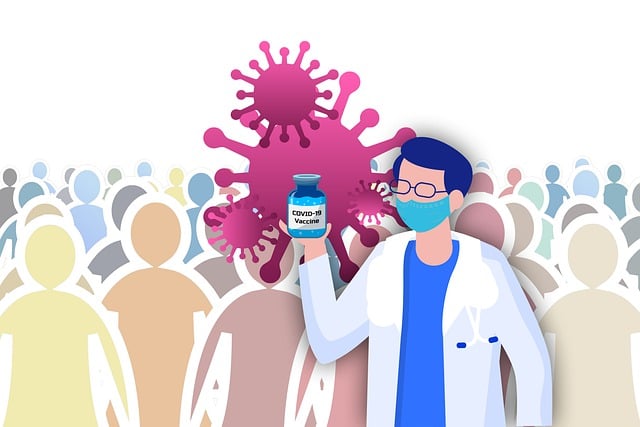TL;DR:
In multicultural UK settings, professional translation services for Vaccine Information Sheets (VIS) are crucial tools that bridge language gaps and enhance patient understanding of vaccination schedules. By providing VIS in native languages, these services improve communication, trust, and informed decision-making among patients, caregivers, and healthcare professionals. This leads to higher vaccine uptake, better adherence to post-vaccination guidance, and ultimately, improved public health outcomes. Integration of translation services within healthcare systems, alongside multilingual support, is a strategic approach to drive successful vaccination programs.
In an increasingly multilingual society, clear communication is vital for patient education. This is particularly crucial when it comes to vaccine information sheets (VIS), which can be critical in informing individuals about potential side effects and next steps. The Role of Clear Communication in Patient Education explores the challenges posed by VIS in a diverse population. This article delves into the benefits of using translated VIS, highlighting how these initiatives enhance patient understanding and engagement. With a focus on best practices, Implementing Translation Services for VIS in the UK provides essential guidance for healthcare providers seeking to improve care through effective multilingual communication.
- The Role of Clear Communication in Patient Education
- Challenges with Vaccine Information Sheets (VIS) in a Multilingual Population
- Benefits of Using Translated VIS: Enhancing Patient Understanding and Engagement
- Implementing Translation Services for VIS in the UK: Best Practices and Considerations
The Role of Clear Communication in Patient Education

In ensuring effective patient education, clear communication is paramount. Vaccine Information Sheets (VIS) play a crucial role in providing essential information about vaccines, their benefits, and potential side effects. However, for patients who are non-native English speakers, understanding VIS can be challenging. This is where translation services for Vaccine Information Sheets UK come into play. Professional translation ensures that VIS are accurately conveyed in languages spoken by the diverse patient population.
By bridging the language gap, translated VIS empower patients to make informed decisions about their health. It allows them to comprehend the vaccine’s role, possible reactions, and what to expect after vaccination. Clear communication fosters trust between patients and healthcare providers, encouraging active participation in their healthcare journey. This, in turn, can lead to better adherence to vaccination schedules and improved overall public health outcomes.
Challenges with Vaccine Information Sheets (VIS) in a Multilingual Population

In many multilingual communities, healthcare providers often face challenges when communicating critical vaccine information to patients and caregivers. Traditional Vaccine Information Sheets (VIS) are typically designed in a single language, which can lead to misunderstandings and barriers to care. This is especially problematic in the UK, where diverse populations may not be fluent in English, hindering their ability to fully comprehend vaccination instructions and potential side effects.
The availability of translated VIS offers a solution to bridge this communication gap. Professional translation services specializing in medical terminology can accurately adapt VIS into various languages spoken within the community. This ensures that patients from diverse linguistic backgrounds receive clear, accessible information about vaccines, fostering informed decision-making regarding their health.
Benefits of Using Translated VIS: Enhancing Patient Understanding and Engagement

Translated Vaccine Information Sheets (VIS) play a pivotal role in bridging communication gaps between healthcare providers and patients, especially in multicultural settings. By ensuring VIS are accessible in various languages, healthcare facilities can significantly enhance patient understanding of their vaccination schedules and related information. This is particularly crucial in the UK, with its diverse population, where effective communication is essential for successful vaccine adoption and public health outcomes.
Using translation services for Vaccine Information Sheets not only improves accessibility but also fosters patient engagement. When patients receive VIS in their native language, they are more likely to comprehend the implications of vaccinations, ask relevant questions, and actively participate in making informed decisions about their health. This leads to higher vaccination rates and improved trust between healthcare providers and diverse communities, ultimately contributing to a healthier society.
Implementing Translation Services for VIS in the UK: Best Practices and Considerations

In the UK, implementing translation services for Vaccine Information Sheets (VIS) is a strategic move to enhance patient understanding and engagement. With a diverse population, ensuring accessible and culturally sensitive VIS is paramount. Best practices involve collaborating with professional translation agencies that specialize in medical terminology and have expertise in translating into various languages spoken within the target demographic.
Considerations should include aligning translations with regulatory requirements, maintaining accuracy and consistency, and integrating translation services seamlessly into existing healthcare systems. Providing multilingual support also facilitates effective communication between patients, caregivers, and healthcare professionals, ultimately improving vaccine uptake and adherence to post-vaccination guidance.
Translated vaccine sheets play a pivotal role in bridging communication gaps within multilingual populations, significantly enhancing patient understanding of their vaccinations. By implementing effective translation services for Vaccine Information Sheets (VIS) in the UK, healthcare providers can foster better engagement and informed consent among diverse patient groups. Best practices include utilizing professional translators, ensuring cultural sensitivity, and integrating translation tools into routine clinical workflows. These measures not only improve accessibility but also contribute to a more inclusive healthcare system, ultimately leading to improved health outcomes. Translation services for VIS in the UK represent a game-changer in patient education, enabling clear communication that every individual can understand.



